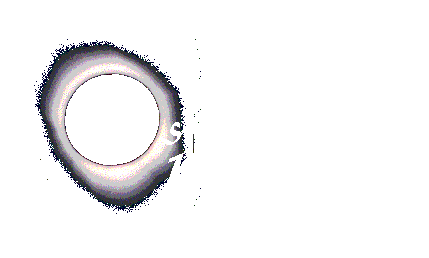

|
In 1963 we encountered our first eclipse. We were living in Newark, Delaware, and driving a VW Beetle with smoked plastic sun visors. Tippi was driving home early one afternoon, when the DJ on the radio announced that the "eclipse was just beginning". She flipped out the visor and looked through it, and sure enough, there was a little nibble out of the sun! She hurried home and built a pinhole viewer out of a packing box which we set up on our front stoop, with a blanket covering to make the viewing area dark enough to see the projected image of the sun. Our son, and all of his neighborhood friends, took turns watching through the pinhole viewer. Other neighbors, walking past, had no idea what we were doing, or that we were in the middle of an eclipse. That is the reason I mention this partial eclipse.. The 1963 event was never more than 85%, and until you reach more than 95% of the sun covered, you would never know you were in an eclipse unless you knew you were in an eclipse and looked for it. |
July 11, 1991 -- Sayulita, MexicoIn 1991 these three interests came together when Larry saw an ad for a tour to Mexico for the express purpose of watching the eclipse. The price was reasonable, we felt comfortable with the destination, and signed up immediately. The name of the group sponsoring this trip was "The Eclipse Edge Group" and their mode was to select a destination not on the center line, but somewhat close the the edge of the path of the eclipse, the reason being that while we would be giving up some of the time of totality, we'd be gaining more time for eclipse edge phenomena. 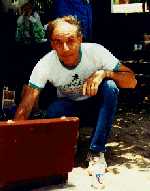 We flew to the resort city of Puerto Vallarta, where we were lodged in a resort hotel. For the several days preceeding the eclipse, we were on our own during the day, but with technical lectures in the evening, preparing us for what lay ahead.
We flew to the resort city of Puerto Vallarta, where we were lodged in a resort hotel. For the several days preceeding the eclipse, we were on our own during the day, but with technical lectures in the evening, preparing us for what lay ahead. On the morning of the eclipse, we boarded busses which took us north to the little town of Sayulita , which lay within the path of the eclipse (Puerto Vallarta did not). The Eclipse Edge Group had arranged to rent the local school yard for the day, for use as a viewing spot for the eclipse. This site was selected because it provided electricity for those who needed it for tracking and timing equipment, and because it provided toilets. What it did not provide was shade. Very quickly someone discovered that there was a beach a few blocks from the school, and some of us moved ourselves and our equipment to the beach. There, as we waited for totality, we were able to enjoy the sea breezes, watch the pelicans and fishermen catching fish just off shore, walk around and discuss the equipment set up and the experiences and expectations of the others on the beach. We were lucky to have within our group a young graduate student in astronomy, who acted as guide and cheerleader through the experience. 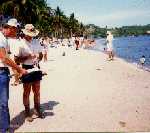 Tippi had a high-end VHS video camera, with variable speed shutter. It was big and heavy and she carried it on her shoulder. She taped the entire event, from the arrival of the busses to Sayulito through totality and packing up afterwards. Sheets had been brought from the hotel and set up on the beach, to show off the shadow bands when they arrived. They arrived, weakly, and are difficult to discern on the video tape. The arrival of second contact (totality) was taped through a welder's filter, held in front of the camera lens with a rubber band arrangement; during totality she switched to a "high speed" mode to avoid overexposure, and removed the filter. With no tripod, she lay on the beach hoping to hold the camera steady, but each time she moved her eye away from the viewfinder, the sun was no longer centered.
Tippi had a high-end VHS video camera, with variable speed shutter. It was big and heavy and she carried it on her shoulder. She taped the entire event, from the arrival of the busses to Sayulito through totality and packing up afterwards. Sheets had been brought from the hotel and set up on the beach, to show off the shadow bands when they arrived. They arrived, weakly, and are difficult to discern on the video tape. The arrival of second contact (totality) was taped through a welder's filter, held in front of the camera lens with a rubber band arrangement; during totality she switched to a "high speed" mode to avoid overexposure, and removed the filter. With no tripod, she lay on the beach hoping to hold the camera steady, but each time she moved her eye away from the viewfinder, the sun was no longer centered. All who attended the eclipse of 1991 declared it "The Perfect Eclipse". All except one -- Tippi! She felt that by viewing event through the viewfinder of her video camera, she missed it completely. And, after viewing her tape, also decided that videotaping or filming of eclipses should be left to the professionals. |
A Scientific explanation of eclipses and eclipse edge phenomenaThe moon is 400x smaller than the sun, but it happens to be 400x closer to the earth than the sun. Thus the disk of the moon and the disk of the sun appear to be the same size. It is this coincidence that allows viewers to see features usually obscured by the brilliance of the sun's light: chromosphere, corona, and prominences. The moon is in an elliptical orbit around the earth. When it is at its closest, its disk will appear larger. The duration of the eclipse will be longer. When the moon is farthest from the earth, its disk does not completely cover the sun. When this occurs, we have an annular eclipse. Several conditions combine to make the best, longest eclipses:
When the moon's shadow first touches the solar disk it is called first contact. When the moon's disk completely covers the sun, we have second contact. And when the moon finally quits the sun's disk it is called 3rd contact. Between 1st (just touching the sun) and 2nd (completely covering the sun) contact the viewer can look for:
|
Nov. 3, 1994 - Atacama desert, Chile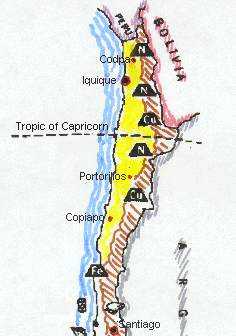 Three years later we again travelled with the Eclipse Edge Group to watch totality from the Atacama desert in Chile. This was a much more extensive trip, requiring greater organization and preparation, and was also much more expensive. We flew to Santiago, and then to the seaside resort city of Iquique .
Three years later we again travelled with the Eclipse Edge Group to watch totality from the Atacama desert in Chile. This was a much more extensive trip, requiring greater organization and preparation, and was also much more expensive. We flew to Santiago, and then to the seaside resort city of Iquique .While in Iquique we took optional side trips up into the Atacama. The Atacama is on a plateau high above the narrow plain where Iqueque is located. The Pan American Highway runs along to top of this cliff. Roads inland into the Atacama turn off from this highway. The Atacama is one of the driest spots on earth. There are places on the Atacama where no rain has fallen in recorded history. The landscape is barren of plants and animals, just rolling hills of dirt and stone. There were towns on the Atacama during the nitrate boom of the late 19th century through WWI. Water was piped down from the Andes for the people in these towns. When the nitrate boom burst, the water was shut off. These towns can still be seen as ghost towns with little decay, certainly no rust. There are also giant petroglyphs in the foothills, made by moving the stones on the surface of the desert in or out of geometric designs. Move the stones in, you get a black pattern. Move them out, the pattern is light tan. No one knows who created these designs or what the purpose. The day before the eclipse, we left the hotel in Iqueque and boarded busses which took us up into the Atacama. At the road where we turned off into the Atacama, there was an army truck with soldiers signaling the busses to turn. And so it was at every turning. The Eclipse Edge Group had arranged with the Chilean Army that their soldiers would guide us to our site, and provision our overnight stay at Codpa. 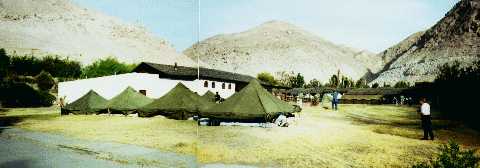 At one of the crossroads, 4 little busses were waiting, and we transferred ourselves and our belongings into the smaller busses. The large busses, which were unable to make some of the turns on the way to Codpa, returned to Iqueque. Codpa is an oasis in a deep depression in the desert. We descended by way of a narrow, steeply switchbacked road into the dpression, where there was a lodge, several small cabins and army tents set up to accomodate us. The cabins were assigned to our most elderly. The rest of us were assigned, 8 to a tent. We had a hot meal and a pre-eclipse talk. A star party was arranged far from the lights of the lodge. For many, this was a first chance to view Southern Hemisphere constellations. Orion was standing on his head. 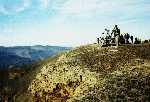 We were wakened very early the next morning, and after a quick breakfast were back in the small busses, which took us to our viewing site, on a rocky prominence overlooking a wide valley. There were as many soldiers at the site as Eclipse Edgers. We set up our equipment and waited.
We were wakened very early the next morning, and after a quick breakfast were back in the small busses, which took us to our viewing site, on a rocky prominence overlooking a wide valley. There were as many soldiers at the site as Eclipse Edgers. We set up our equipment and waited. Tippi, true to her vows, put down her camera, the better to experience the eclipse. But there was little edge phenomena to see. No birds to settle in the trees, no trees to offer pinhole projections. High cirrus clouds interferred with shadow bands, but not with the eclipse itself. It was a short eclipse, and satisfying, but not perfect. |
Feb. 26, 1998 - Paraguana Peninsula, VenezuelaWe made our way slowly from Caracus, westward to the Paraguana Peninsula , which juts out into the Carribbean Ocean. The entire peninsula was in the path of the eclipse. The Paraguana Peninsula is not ordinarily visited by tourists; it consists mostly of low lying scrub; part of it is given over to an oil refinery and the city of Punto Fino serves the refinery. We were booked into the only hotel in town. 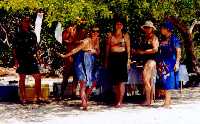 Tippi had made friends with another woman in the group, Maria, and the two of them decided they'd view the eclipse from the hotel. They wanted to avoid the primitive conditions of the viewing site, where a latrine would be dug in the sandy soil with only a blanket for privacy, and the early departure and the standing all day in the unshaded heat. The hotel would be in the path of totality (although closer to the edge).
Tippi had made friends with another woman in the group, Maria, and the two of them decided they'd view the eclipse from the hotel. They wanted to avoid the primitive conditions of the viewing site, where a latrine would be dug in the sandy soil with only a blanket for privacy, and the early departure and the standing all day in the unshaded heat. The hotel would be in the path of totality (although closer to the edge). And so, the next morning, as the group departed from the hotel at 5:30 am, Tippi waved good bye and returned to her hotel room for an hour's extra sleep. Then she joined Maria for a leisurely breakfast in the hotel diningroom, after which they set up lounge chairs by pool's edge and waited. She had her camera with her, which she clamped to a chair and pointed at a white towel, in hopes of capturing shadow bands. As the eclipse approached, she turned it on, and let it run throughout the event. The hotel diningroom overlooked the pool, and had several tables set up at poolside. A number of Punto Fino families came to the hotel that day for lunch and the eclipse. As the eclipse drew near, these families drifted out to the tables at poolside. 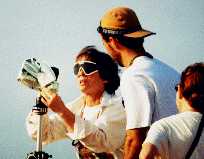 The eclipse approached. The light became weird. Everything quieted, and the air cooled. And then -- the sun was obscured. Several young Venezuelan children began screaming. Not merely crying out, these were screams of pure terror, echoing the screams of primitive people through the ages when encountering this unfamiliar, frightening experience unexpectedly.
The eclipse approached. The light became weird. Everything quieted, and the air cooled. And then -- the sun was obscured. Several young Venezuelan children began screaming. Not merely crying out, these were screams of pure terror, echoing the screams of primitive people through the ages when encountering this unfamiliar, frightening experience unexpectedly.Tippi concentrated on the beauty of the eclipse, but next to her, the camera was running, capturing the screams of the children on its sound track. Later that afternoon, the eclipse group returned. They reported a wonderful experience, everyone convinced they had snapped the picture of a lifetime. They also reported that there were over 300 Japanese astronomers camped out at the site, and all the TV networks were set up there, and just before totality the President of Venezuela was helicoptered in, saw the eclipse and left immediately after it was over. They also reported that early in the morning the Venezuelan army had sealed off the peninsula. |
| Herodotus writes of an eclipse which ended a five year war between the Lydians and the Medes, who were locked into battle when "the day was turned into night". The sight of this total solar eclipse (May 28, 585 BC) was startling enought to cause both nations to stop fighting at once. |
Aug. 11, 1999 - Yesil Irmak, Turkey Even had there been no eclipse, this trip would still have been a highlight trip of a lifetime. We saw so much history in the two weeks we were in the country! In Istanbul we stayed in a hotel within walking distance of the Blue Mosque and the Hagia Sophia, and also toured the underground cistern and Topkapi, and shopped at the Grand Bazaar. We went to classical Greek/Anatolian cities of Troy, Efes, Pergamon and Aphrodesias; to Hattusas, a Hittite site; to Kerkenes, the site of the battle halted by the eclipse; We spent an afternoon at Catal Huyak, the ruins of a city dating from 7,000 bc where statues of the goddess have been unearthed and where digging continues; the same week that our church at home was offering a program on Sufi music and mysticism, we were in Konya at the Malvina Mosque, birthplace of the Sufi movement.
Even had there been no eclipse, this trip would still have been a highlight trip of a lifetime. We saw so much history in the two weeks we were in the country! In Istanbul we stayed in a hotel within walking distance of the Blue Mosque and the Hagia Sophia, and also toured the underground cistern and Topkapi, and shopped at the Grand Bazaar. We went to classical Greek/Anatolian cities of Troy, Efes, Pergamon and Aphrodesias; to Hattusas, a Hittite site; to Kerkenes, the site of the battle halted by the eclipse; We spent an afternoon at Catal Huyak, the ruins of a city dating from 7,000 bc where statues of the goddess have been unearthed and where digging continues; the same week that our church at home was offering a program on Sufi music and mysticism, we were in Konya at the Malvina Mosque, birthplace of the Sufi movement. Our viewing site was in north central Turkey, on the top of a hill overlooking the valley of Yesil Irmak. Again, we had Army cooperation, as our hill also housed a microwave antenna, which they were guarding. We began to set up. Guy Ottewell had assigned viewing tasks to some of us; one was to observe and report on the diamond ring; another on the appearance of stars and planets; Tippi was assigned the shadow bands. She spread out a cloth brought from the hotel, although she had not brought her camera. The sky was clear, but with fluffy white clouds. A discussion arose between the participants over whether the clouds were more likely to hang over the top of a high hill, such as the one we were on, or over the valley. Those who believed that the valley was more likely to be clear comandeered a bus and took it back to a farmer's field in the valley. As it turned out, both groups were right and saw an unobscured eclipse. 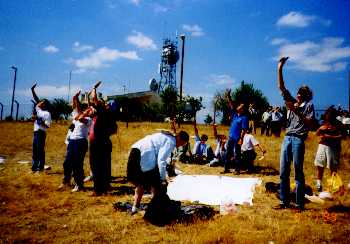 The following is excerpted from Tippi's journal for that day:
The following is excerpted from Tippi's journal for that day:From my perch on the top of the hill I could see the shadow of the eclipse coming toward me at enormous speed, and it was so dark it looked almost solid, so dark and so fast it was alarming and I feared I would be knocked over. Then, suddenly, the shadow bands appeared. They were so strong, and of such long duration, that the tablecloth was unnecessary. They danced over the grass, over the cloth, over the bodies and faces of my companions. I was astounded. I had the feeling that these bands of light and shade were "beaming" me into an alien world --- And then, suddenly, I was in that alien world, so unlike the earth I knew. Around the horizon was a rosy dawn, but overhead was a dome of dusky blue, with stars and other celestial bodies. And queen of this dome was the eclipsed sun, hanging there, quiet, with the corona undulating in shades of pink and lavender. It was so beautiful. Were I not a modern woman, knowing the mechanics of this wonderous event, I would have fallen to my knees and raised my hands in supplication to this omen of the god on whom we cannot look without being blinded, and pledged my allegiance forever. But I am a modern woman, and I did not fall to my knees. Still, I felt a powerful awe, barely daring to breath during the eclipse. And then it was over. The diamond ring foretold the return to my own universe, and the shadow bands returned. Within a few minutes the sun seemed to have returned to it's former strength and we were back on our familiar earth." It was a perfect eclipse. It was more than that; it answered some questions that Tippi had been asking since she was in her teens: "Just how did all these religions start? And how could people believe in that stuff anyway?" Now she knew. |
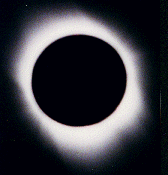 |
|
So, now that we have had our perfect eclipse, are we done? Not at all. Financial reasons kept us from the eclipse in Africa this year, but there will be another in 2006, in Turkey, and we plan to be there. There will be one in the United States in 2017. We may not be around for that one, but all who are able should get themselves to the states that will be affected; from Washington/Oregon sweeping towards Tennessee. |
|
Here is the video from the 1998 eclipse in Venezuela - you can hear the screams of the frightened children.
|